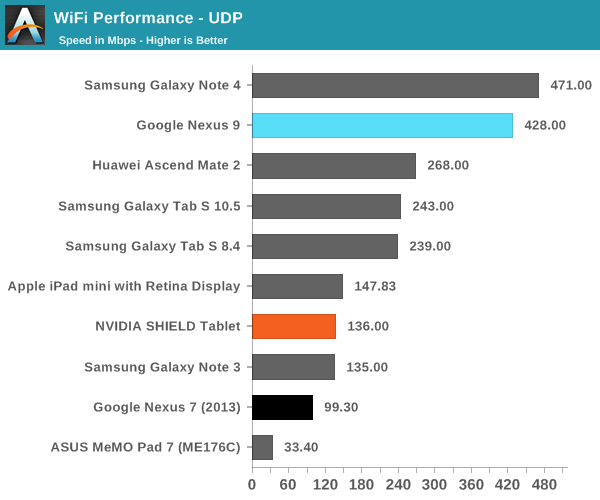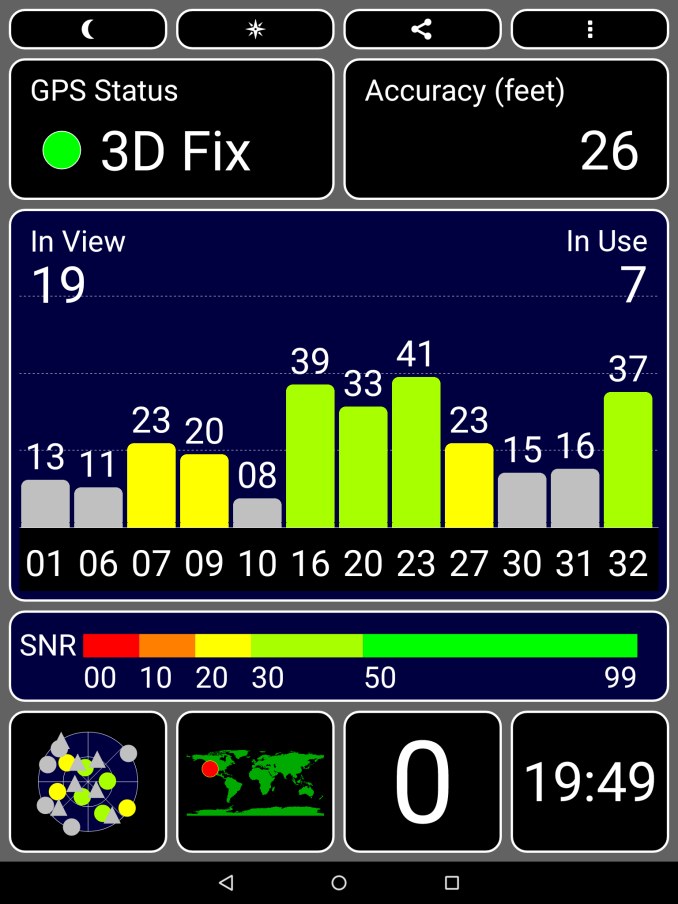The Google Nexus 9 Review
by Joshua Ho & Ryan Smith on February 4, 2015 8:00 AM EST- Posted in
- Tablets
- HTC
- Project Denver
- Android
- Mobile
- NVIDIA
- Nexus 9
- Lollipop
- Android 5.0
WiFi Performance
On most tablets, WiFi performance is perhaps one of the most crucial parts of the experience as WiFi is often the primary method of connectivity. Without working WiFi, a tablet is basically useless as the only alternative is either cellular (which is quite rare on most tablets) or Ethernet over USB-OTG, which destroys most of the value of a mobile device.
In the case of the Nexus 9, we see that HTC has fitted this device with a BCM4354 WiFi module to enable two spatial stream 802.11ac. Interestingly, there is some evidence to suggest that HTC has also adopted Cypress Semiconductor’s CapSense controller to enable antenna tuning for the WiFi antennas. However, it’s probable that this solution is only for HTC devices without a Qualcomm Gobi modem as we’ve seen the use of the QFE15xx antenna tuner in previous HTC products. In order to test how the Nexus 9’s WiFi solution performs, we turn to iperf on Android to test throughput across the network, and utilize Asus’ RT-AC68U router to ensure that the device under test will be able to reach maximum performance.

The Nexus 9's WiFi solution performs about as well as one might expect from a BCM4354 solution. For the most part I haven't noticed any reception issues, even when touching/detuning the WiFi antennas.
GNSS
While most of the GNSS solutions that we’ve looked at this year use Qualcomm’s GPSOne/IZat due to the presence of a Qualcomm Gobi Modem, the same isn’t true for the Nexus 9. Instead, Broadcom’s BCM4752 is used here. While this shouldn’t have a massive impact on the speed with which first lock is acquired, in practice Qualcomm’s solution is noticeably faster here as the modem can often provide data to make for a hot fix. At any rate, the Nexus 9 does perform acceptably in this regard. I don’t see any major issues with location performance, although it does seem that the GPS tends to report lower accuracy levels than the Qualcomm solutions that I'm used to. Other than this, the GNSS solution is quite usable.
Misc
While we don't have a proper audio quality test yet, it's clear that the audio codec used is the same Realtek RT5677 codec that we saw in the SHIELD Tablet. Outside of the code, we also see an RT5506 2.55V amp on the 3.5mm jack, along with two NXP TFA9895 amps on the speakers, which are quite good due to their front-facing placement. In practice I don't really see much issue with loudness or quality here, as the speakers can get even louder than the M8 in some situations. We also see a Broadcom BCM2079x NFC chip, which means HCE is fully supported out of the box. Interestingly, the VCM controller is exposed to the OS and is said to be a Texas Instruments DRV201 chip.











169 Comments
View All Comments
Mondozai - Wednesday, February 4, 2015 - link
No offence but how relevant is this review so many months after release?You guys dropped the ball on this one. We're also still waiting for the GTX 960 review.
What has happened to Anandtech...
LocutusEstBorg - Wednesday, February 4, 2015 - link
There's no Anand.nathanddrews - Wednesday, February 4, 2015 - link
That's the only change I've noticed.Morawka - Wednesday, February 4, 2015 - link
and no Brian Klugnathanddrews - Wednesday, February 4, 2015 - link
Yeah, but that was earlier.Ryan Smith - Wednesday, February 4, 2015 - link
"What has happened to Anandtech..."Nothing has happened to AnandTech. We're still here and working away at new articles.=)
However this article fell victim to bad timing. The short story is that I was out sick for almost 2 weeks in December, which meant this got backed up into the mess that is the holidays and CES.
As for how relevant it is, it is still Google's premiere large format tablet and the only shipping Denver device, both of which make it a very interesting product.
Jon Tseng - Wednesday, February 4, 2015 - link
It's fine to be late (although maybe not as late as the Razer Blade 2014 review!). Better to have late, differentiated content than early, commoditised content. Whether the review like's the colour of a tablet's trim is of limited interest for me; the details of Denver code-morphing are.Actually my worry is that under new ownership Anandtech might be pushed to go down the publish early/get click views route vs. the publish late/actually deliver something useful. Hopefully it won't come to this, but this is what historically happens... :-(
Operandi - Thursday, February 5, 2015 - link
Being there on day one is not a huge deal but its certainly not ok be as late as this review is or the still MIA 960 review. If you are going to be late you better be brining something new to the table to justify not being there in the same time frame as your peers. This is so laughably late its almost embarrassing to release it at all at this point.Tech journalism like most other markets is competitive and there are lots of other very competent publications out there competing for the same readers. Personally I've already gotten all the Nexus 9 information elsewhere so this review is of no value to me whatsoever. The same goes for the 960 review when/if that review ever shows up.
akdj - Wednesday, February 11, 2015 - link
Not sure where you've seen such an extensive write up and dissection of Denver, but I certainky haven't. Nor were the N9/6 widely available until the holidays were over. Like a month agoFor every 10,000,000 iPads produced, HTC is probably knocking out 10,000
Excellent review, write up and information about the 'other 64bit' option.
Taneli - Wednesday, February 4, 2015 - link
Timing is secondary for a deeply technical article like this here. You guys did exactly the right thing, reporting when the device was announced and waited for the review to be done before publishing. Also, having people out sick in a small team is something you really can't do that much about. I hope you're well now.The article itself was superb. Thanks for the read and keep up the good work.